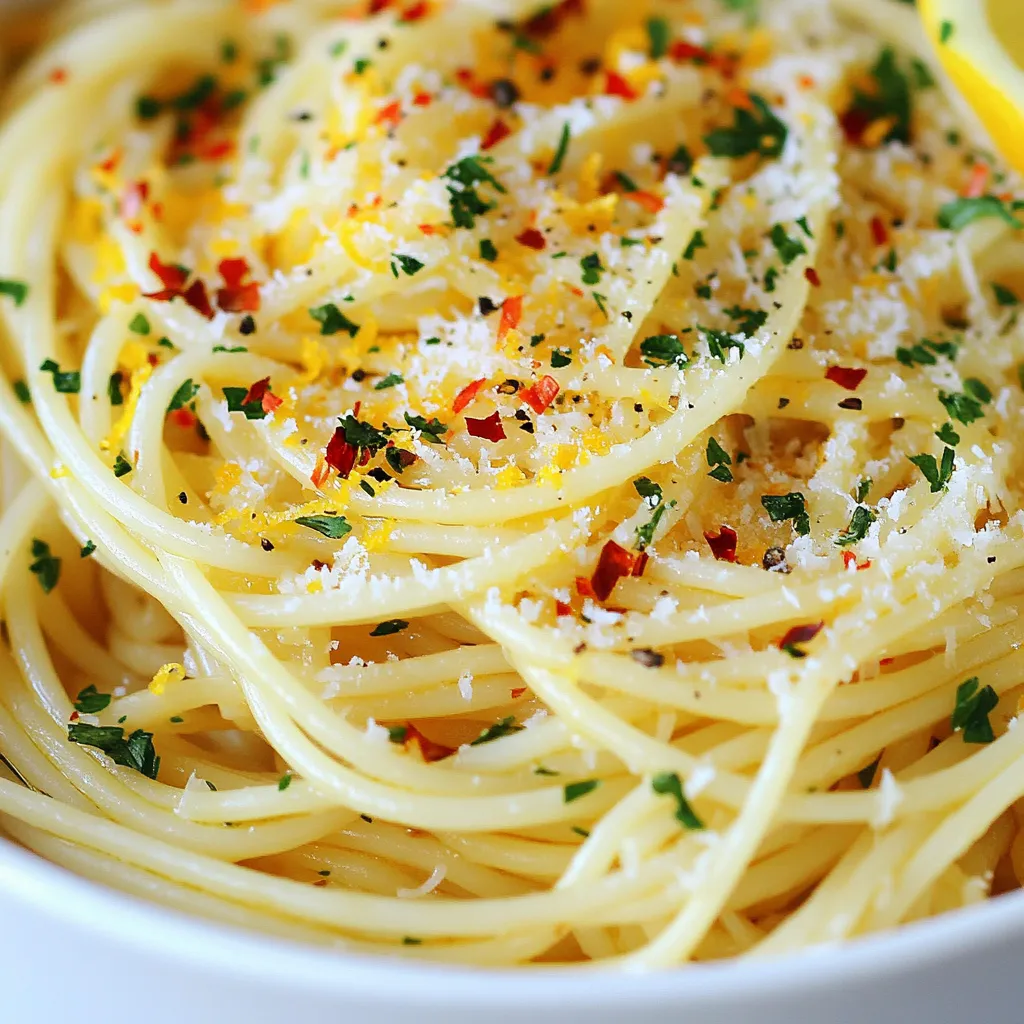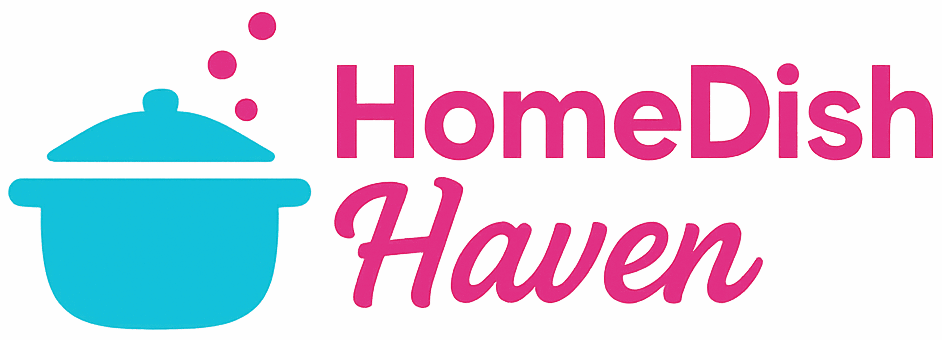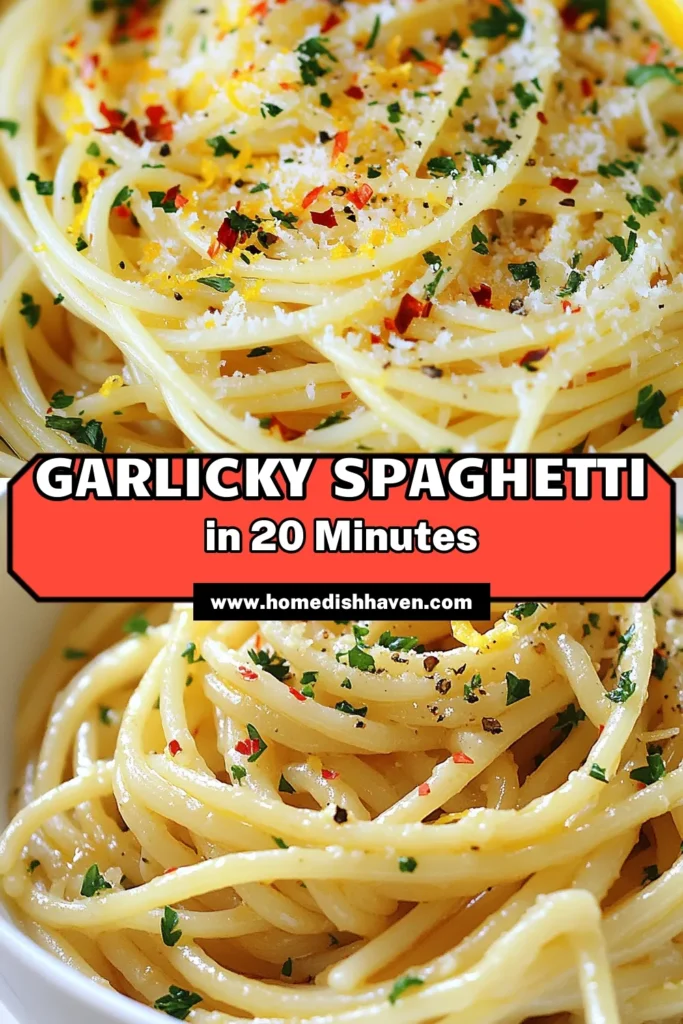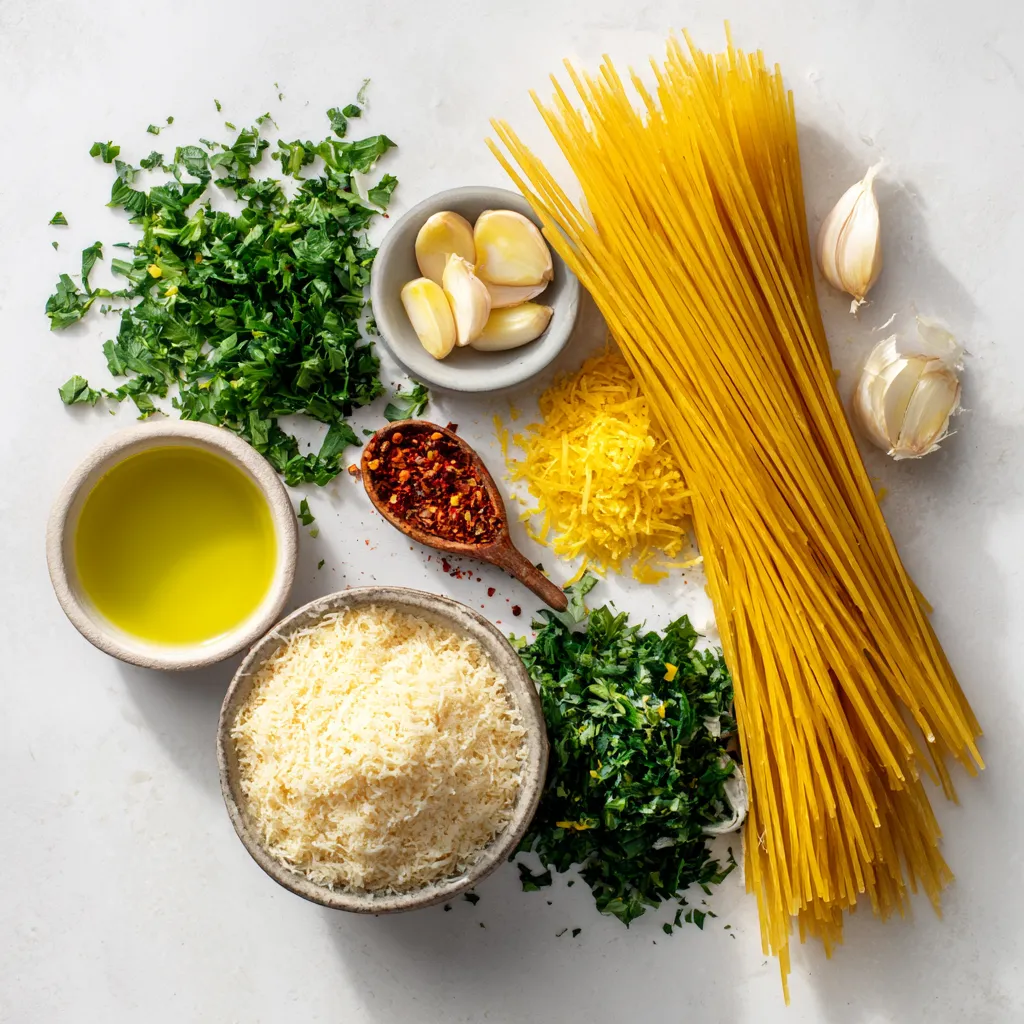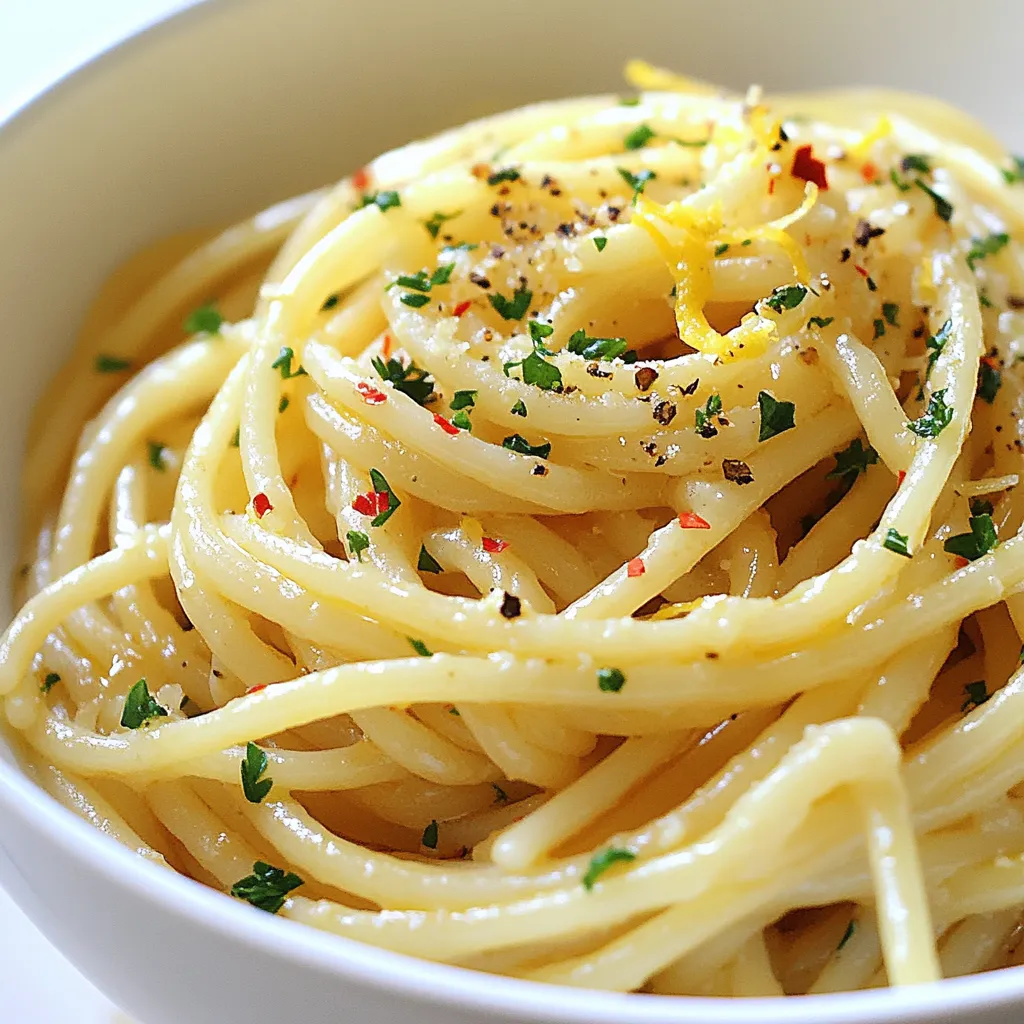WANT TO SAVE THIS RECIPE?
If you crave a simple and flavorful dish, Spaghetti Aglio e Olio is for you. With just a few ingredients, you can whip up this classic Italian meal in no time. This quick recipe highlights the bold taste of garlic and olive oil, making it a perfect choice for busy weeknights. Ready to impress your taste buds with minimal effort? Let’s dive into this savory and easy dish!

Why I Love This Recipe
- Quick and Easy: This recipe comes together in just 20 minutes, making it perfect for busy weeknights or last-minute gatherings.
- Flavorful Ingredients: The combination of garlic, olive oil, and lemon zest creates a deliciously aromatic dish that excites the taste buds.
- Customizable: You can easily adjust the spice level by adding more or less red pepper flakes, or even incorporate other vegetables or proteins.
- Healthy and Light: Made with simple and wholesome ingredients, this spaghetti dish offers a guilt-free indulgence that feels great.
Ingredients
Main Ingredients for Spaghetti Aglio e Olio
– 400g spaghetti
– 6 cloves of garlic, thinly sliced
– 1/2 cup extra virgin olive oil
– 1 teaspoon red pepper flakes
– Salt, to taste
– 1/4 cup fresh parsley, chopped
– Zest of 1 lemon
– Grated Parmesan cheese (optional, for serving)
Essential Cooking Tools
– Large pot
– Colander
– Large skillet
– Tongs or spatula
The heart of Spaghetti Aglio e Olio lies in its simple yet bold ingredients. You start with spaghetti, the base of your dish. I recommend using 400g for four servings. The garlic is the star here, so six cloves, thinly sliced, will give you that rich flavor. Extra virgin olive oil is key too, about 1/2 cup, to create a garlicky sauce.
Next, we need a kick of spice, so grab 1 teaspoon of red pepper flakes. Salt is essential, but you’ll add that to taste later. Freshness comes from 1/4 cup of chopped parsley and the zest of one lemon for brightness. If you want to indulge, sprinkle some grated Parmesan cheese on top when serving.
Now, let’s talk tools. A large pot is a must for boiling your pasta. A colander will help you drain it. You’ll need a large skillet to infuse the olive oil with garlic. Lastly, tongs or a spatula are great for mixing everything together.
With these ingredients and tools, you’re set to make a delicious Spaghetti Aglio e Olio. Each component plays a vital role in creating a dish that’s both simple and satisfying.

Step-by-Step Instructions
Cooking the Spaghetti
1. Bringing water to a boil: Fill a large pot with water. Add a good amount of salt. Turn the heat to high and wait for it to boil. You want a rolling boil.
2. Cooking to ‘al dente’: Once the water is boiling, add the spaghetti. Cook it for about 8 to 10 minutes. Check the package for exact times. You want it to be firm but not too hard.
3. Reserving pasta water: Before draining the spaghetti, scoop out about 1 cup of the pasta water. This water will help make your sauce. Drain the spaghetti in a colander.
Infusing the Olive Oil
1. Heating the oil: Take a large skillet and pour in the extra virgin olive oil. Heat it on medium. You want it warm, not smoking.
2. Sautéing garlic without burning: Add the thinly sliced garlic to the oil. Stir it often for about 2 to 3 minutes. Wait until it turns golden. Be careful not to burn it, or it will taste bad.
Combining Ingredients
1. Adding red pepper flakes: Now, sprinkle in the red pepper flakes. Stir them in and let them cook for about 30 seconds. This brings out their heat.
2. Mixing spaghetti with oil and reserved water: Add the drained spaghetti to the skillet. Pour in the reserved pasta water. Use tongs to toss everything together. Ensure the spaghetti is well-coated.
3. Tossing and seasoning: If it feels dry, add more reserved water slowly. Taste and sprinkle in salt as needed. Toss in fresh parsley and lemon zest. Mix until everything looks vibrant and tasty.
Tips & Tricks
Perfecting the Garlic Flavor
To get the best garlic flavor, make sure to sauté it gently. Keep the heat on medium. This way, the garlic becomes golden and fragrant without burning. If the garlic burns, it can taste bitter.
Adjust the oil to your liking. If you want a richer taste, add more olive oil. Just remember, the oil helps carry the garlic’s flavor.
Achieving the Right Sauce Consistency
Using reserved pasta water is key. Before draining your spaghetti, save about one cup of that starchy water. This helps thicken your sauce. When you mix the spaghetti with the oil, add a little reserved water at a time. This makes the sauce creamy and smooth.
Taste and adjust the seasoning. Add salt as needed. Fresh parsley and lemon zest boost flavor and color. Toss everything well to blend.
Presentation Tips
For a beautiful dish, garnish with chopped parsley and lemon zest. This adds a fresh touch. Consider serving with crusty bread. It gives a nice crunch to the meal and is great for scooping up any leftover sauce.
Pro Tips
- Use Fresh Garlic: Fresh garlic provides a more vibrant flavor compared to pre-minced garlic. Always opt for whole cloves and slice them just before cooking.
- Reserve Pasta Water: The starchy pasta water is a key ingredient for adjusting the sauce’s consistency. Add it gradually to achieve the desired creaminess.
- Don’t Overcook the Garlic: Sauté the garlic until it’s just golden. Overcooking can lead to a bitter taste, ruining the dish.
- Experiment with Herbs: While parsley is traditional, feel free to experiment with other fresh herbs like basil or oregano for a unique twist on flavor.

Variations
Adding Protein
You can easily add protein to your spaghetti aglio e olio. Shrimp and chicken work great. If you choose shrimp, cook it in the skillet before adding garlic. Cook the shrimp until pink, about 2-3 minutes per side. For chicken, cut it into small pieces. Sauté it until cooked through, about 5-7 minutes. This extra step gives your dish more flavor and makes it heartier.
Vegetable Additions
Adding vegetables brightens the dish. Spinach and broccoli are popular choices. If you use spinach, add it just before the spaghetti. It wilts quickly and adds nice color. For broccoli, steam it for a few minutes first, then mix it in. Adjust the cooking time based on the veggies you choose. You want them tender but still crisp.
Other Flavor Enhancements
Want to spice things up? Try adding capers or olives. Capers give a tart, briny flavor that works well with garlic. Olives add depth and richness. You can also add more chili flakes for extra heat. Just sprinkle a bit in while you sauté the garlic. Taste as you go to find your perfect balance.
Storage Info
Storing Leftovers
To keep your Spaghetti Aglio e Olio fresh, store it in the fridge. Use an airtight container. This helps keep moisture in and prevents it from drying out. Make sure to let the pasta cool down before sealing it. Leftovers are best eaten within three days for optimal taste.
Reheating Instructions
When reheating spaghetti, the best method is to use a skillet. Heat it on low. Add a splash of water or olive oil to keep it moist. Stir gently to combine the flavors. If you prefer the microwave, place pasta in a bowl with a little water. Cover it and heat in short bursts. This keeps the flavor vibrant.
Freezing Spaghetti Aglio e Olio
To freeze, let the pasta cool completely. Pack it in a freezer-safe bag. Press out extra air before sealing. It stays good for up to three months. When ready to eat, thaw in the fridge overnight. To reheat from frozen, place in a skillet with a bit of oil or water. Heat slowly, stirring until warm. Enjoy your meal!
FAQs
What is Spaghetti Aglio e Olio?
Spaghetti Aglio e Olio is a simple Italian pasta dish. It means “spaghetti with garlic and oil” in English. This dish comes from Naples and is popular for its bold flavors and ease of preparation. It uses just a few ingredients: spaghetti, garlic, olive oil, and red pepper flakes. The dish highlights the beauty of basic cooking with fresh, quality ingredients.
How long does Spaghetti Aglio e Olio last in the fridge?
Spaghetti Aglio e Olio can last in the fridge for about three days. To keep it fresh, store it in an airtight container. When you’re ready to eat, just reheat it in a skillet or microwave. You may need to add a splash of olive oil or water to help revive the flavors.
Can I make Spaghetti Aglio e Olio vegan?
Yes, you can easily make Spaghetti Aglio e Olio vegan. Simply skip the grated Parmesan cheese, or use a plant-based cheese. The dish is already vegan-friendly, as it mainly relies on garlic, oil, and herbs. This makes it a great option for everyone. Enjoy the same tasty flavors without any animal products!
Spaghetti Aglio e Olio is simple yet full of flavor. You only need a few ingredients and tools. Cooking the pasta perfectly and infusing the oil with garlic matters most. Don’t forget to add your favorite proteins or veggies for variety. Leftovers can be stored or frozen easily.
With these tips, you can impress anyone with this quick dish. Enjoy making your own Spaghetti Aglio e Oli
Garlicky Spaghetti Delight
A flavorful spaghetti dish infused with garlic and topped with fresh parsley and lemon zest.
Prep Time 10 minutes mins
Cook Time 10 minutes mins
Total Time 20 minutes mins
Course Main Course
Cuisine Italian
Servings 4
Calories 400 kcal
- 400 g spaghetti
- 6 cloves garlic, thinly sliced
- 0.5 cup extra virgin olive oil
- 1 teaspoon red pepper flakes
- to taste none salt
- 0.25 cup fresh parsley, chopped
- 1 none zest of lemon
- optional none grated Parmesan cheese, for serving
In a large pot, bring water to a rolling boil, adding a generous amount of salt. Once boiling, carefully add the spaghetti and cook according to package instructions until it reaches an 'al dente' texture, usually around 8-10 minutes. Before draining, reserve about 1 cup of the pasta water, then drain the spaghetti thoroughly in a colander.
In a large skillet, pour in the extra virgin olive oil and heat it over medium heat. Once the oil is warm, add the thinly sliced garlic. Sauté gently, stirring frequently until the garlic becomes golden and fragrant; this should take about 2-3 minutes. Pay close attention to avoid burning the garlic, which can turn bitter.
To the skillet with the garlic, introduce the red pepper flakes. Stir them in and allow to cook for an additional 30 seconds, which will help to release their spicy flavor into the oil.
Add the drained spaghetti directly into the skillet, followed by the reserved pasta water. Use tongs or a spatula to toss everything together, ensuring the spaghetti is well coated in the garlicky oil. If the mixture appears too dry, gradually add more reserved pasta water until you achieve your preferred sauce consistency.
Sprinkle salt according to your taste preference. Add in the fresh chopped parsley and lemon zest, tossing everything together again until the spaghetti is vibrantly coated with color and flavor.
Dish the garlicky spaghetti into serving bowls. If desired, finish with a generous sprinkle of grated Parmesan cheese for added richness.
For an appealing finish, garnish each plate with a fresh sprinkle of chopped parsley and a twist of lemon zest. Consider serving alongside a slice of crusty bread for a delightful contrast in texture.
Keyword easy, garlic, pasta, spaghetti
WANT TO SAVE THIS RECIPE?
